Thyme is one of the most beloved herbs in the culinary world, known for its subtle yet robust flavor and incredible versatility. Whether you’re a seasoned cook or a beginner in the kitchen, thyme can enhance your dishes in ways both simple and profound. This article explores how to cook with thyme, its different varieties, methods for incorporating it into recipes, and tips on pairing it with other ingredients to elevate your meals.
1. What is Thyme?
Thyme (Thymus vulgaris) is a small, woody herb native to the Mediterranean region. Its leaves are small, oval, and highly aromatic, giving off an earthy, slightly minty fragrance. While it’s most commonly used in dried form, fresh thyme adds a vibrant flavor to many dishes. Beyond its culinary uses, thyme has been revered for its medicinal and preservative properties for centuries, used in traditional remedies for respiratory issues, digestion, and overall wellness.
Varieties of Thyme

Thyme is a staple herb in kitchens around the world, but many people may not realize that it comes in several distinct varieties, each with its own flavor profile and culinary applications. Understanding the differences between these varieties can significantly enhance your cooking, as certain types of thyme complement specific dishes more effectively than others. Below is a deeper dive into some of the most popular varieties of thyme, exploring their unique flavors, uses, and ideal pairings in cooking.
a. Common Thyme (Thymus vulgaris)
This is the thyme variety most people are familiar with, as it’s widely available and versatile. Common thyme has a balanced, earthy flavor with hints of mint and pepper, which makes it a staple in both everyday and gourmet cooking.
- Flavor Profile: Mildly earthy, slightly minty, and subtly peppery, common thyme offers a well-rounded flavor without overwhelming other ingredients.
- Culinary Uses: Common thyme works well in a broad range of dishes, making it the go-to choice for recipes that call for thyme. It’s a great addition to roasted meats, hearty soups, stews, casseroles, and sauces. It’s also a key herb in Mediterranean and French cooking, commonly used in dishes like ratatouille, coq au vin, and lamb roasts.
- Best Pairings: Common thyme pairs well with garlic, onions, tomatoes, olive oil, and a variety of proteins such as chicken, beef, pork, and fish. It’s also excellent in herb blends like bouquet garni and herbes de Provence.
b. Lemon Thyme (Thymus citriodorus)
Lemon thyme is a fragrant variety known for its refreshing citrus aroma and flavor, which adds a bright, zesty note to dishes. It’s particularly well-suited for lighter fare and can bring a lively twist to both savory and sweet recipes.
- Flavor Profile: Strong lemony scent with subtle thyme undertones. It has a fresh, citrusy brightness that balances out thyme’s earthier notes.
- Culinary Uses: Lemon thyme is ideal for seafood dishes such as grilled or baked fish, shrimp, or scallops. It also works well with poultry, especially in marinades or roast chicken dishes. The citrus element makes lemon thyme a fantastic addition to vinaigrettes, sauces, and even desserts like lemon cakes, sorbets, or fruit salads.
- Best Pairings: This variety pairs beautifully with lemon, garlic, olive oil, and seafood. It can also enhance the flavor of dishes featuring asparagus, potatoes, or mushrooms. In desserts, lemon thyme complements citrus fruits and berries, adding complexity to sweet treats.
c. Orange Thyme (Thymus fragrantissimus)
Orange thyme is a less common but delightful variety that brings a fragrant orange scent and flavor to dishes. It has a similar citrusy profile to lemon thyme but with distinct orange notes that can be more delicate and sweet.
- Flavor Profile: Delicate and sweet, with a bright orange aroma that complements thyme’s earthy base. It has a slight sweetness, making it perfect for both savory and sweet applications.
- Culinary Uses: Orange thyme is an excellent choice for dishes where you want a touch of sweetness along with herbal flavor. It’s particularly good in marinades for chicken, pork, or duck, and it can be used in glazes for roast meats. On the sweet side, it works well in baked goods, syrups, and fruit compotes, providing a floral-citrus note that pairs well with desserts.
- Best Pairings: Orange thyme pairs wonderfully with honey, cinnamon, ginger, and fruits like oranges, apples, and peaches. In savory dishes, it complements roasted vegetables, root vegetables, and poultry. It’s also great for enhancing salad dressings or herb-infused butters.
d. Caraway Thyme (Thymus herba-barona)
Caraway thyme is a more unusual variety that has a distinctive caraway seed-like flavor, making it an excellent choice for breads, stews, and other hearty dishes. It is often used in traditional Mediterranean and Middle Eastern recipes.
- Flavor Profile: Rich and aromatic, with strong caraway and anise undertones. This thyme variety brings an almost spice-like flavor that makes it particularly unique among the other varieties.
- Culinary Uses: Caraway thyme is particularly suited for dishes where its slightly spicy, earthy flavor can stand out. It’s perfect for flavoring hearty bread recipes, especially those featuring rye or whole grains. Additionally, it works well in stews, casseroles, and slow-cooked meats such as lamb or beef. It can also be used in sausages or charcuterie for an extra layer of flavor.
- Best Pairings: This variety pairs well with earthy and warm spices like cumin, coriander, and fennel. It’s excellent in bread doughs, casseroles, and baked dishes. Caraway thyme also complements roasted root vegetables and pairs nicely with fatty meats like pork or lamb.
e. Wild Thyme (Thymus serpyllum)
Also known as creeping thyme, wild thyme is found growing in the wild in many parts of Europe, especially in the Mediterranean region. It has a more intense flavor than cultivated varieties and is often used in traditional, rustic recipes.
- Flavor Profile: Bold, intense, and more aromatic than common thyme. Its flavor is earthy, slightly pungent, and almost spicy, with a robust aroma.
- Culinary Uses: Due to its strong flavor, wild thyme is often used sparingly in cooking. It’s commonly found in Mediterranean dishes, where it adds depth to grilled meats, game, and vegetable dishes. It also works well in marinades for robust meats like lamb, beef, or venison, as well as in hearty stews and soups. Wild thyme is sometimes used in herbal teas and infusions for its medicinal properties.
- Best Pairings: Wild thyme pairs well with other strong flavors such as rosemary, garlic, black pepper, and red wine. It’s often used in combination with bold, gamey meats or roasted vegetables, and its robust character stands up well to long cooking times in stews or braises.
Other Notable Thyme Varieties
In addition to these popular types, there are a few lesser-known varieties of thyme worth exploring:
- Silver Thyme (Thymus vulgaris ‘Argenteus’): A striking variety with silver-edged leaves and a mild, sweet flavor. It’s commonly used as a garnish or decorative plant, but it also works well in light, delicate dishes.
- Creeping Thyme (Thymus praecox): Often used as ground cover in gardens, creeping thyme has a mild flavor and can be used in the kitchen similarly to common thyme. Its small leaves make it perfect for salads or as a garnish.
- Woolly Thyme (Thymus pseudolanuginosus): A low-growing variety with soft, fuzzy leaves. Though less common in cooking, it can still be used in soups or as an attractive garnish.
With so many varieties of thyme available, the herb offers endless possibilities in the kitchen. From the classic, all-purpose flavor of common thyme to the zesty notes of lemon and orange thyme, each type can bring a unique touch to your dishes. Whether you’re cooking meats, vegetables, or even desserts, thyme’s versatility and wide flavor spectrum can help you tailor your meals to perfection. Experimenting with different thyme varieties will not only enhance your dishes but also deepen your appreciation for this ancient and indispensable herb.
2. Culinary Uses of Thyme
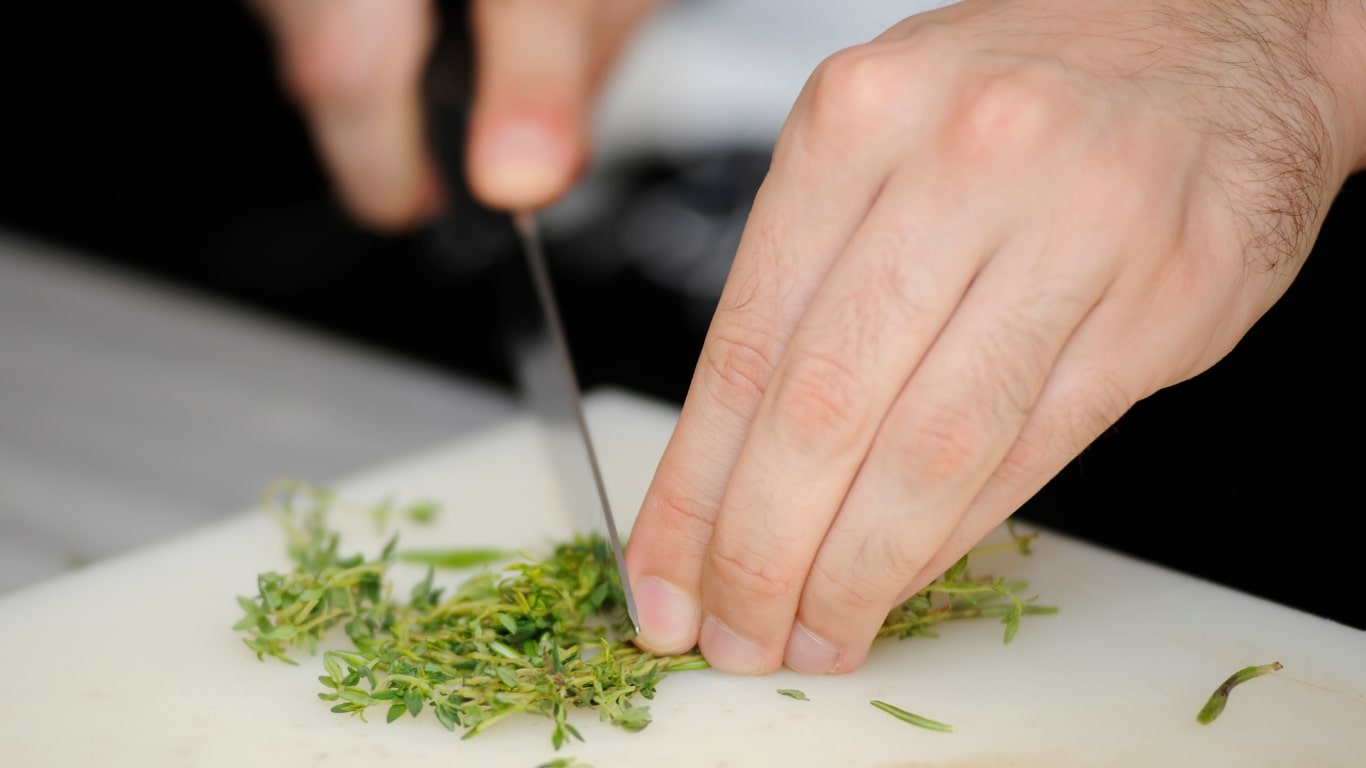
a. Thyme in Everyday Cooking
Whether used fresh or dried, thyme enhances the depth, aroma, and complexity of meals, bringing warmth and an herbal undertone that enhances a dish without overshadowing the other ingredients. Below, we’ll explore in more detail how thyme can elevate your everyday cooking.
Thyme in Stews and Soups
Thyme’s earthy and slightly minty flavor is a natural fit for stews and soups. In dishes that require slow cooking, like beef stew, chicken soup, or vegetable broth, thyme plays a critical role by infusing the liquid with deep, rich flavors over time.
When thyme is simmered for long periods, its essential oils are slowly released, providing an earthy, herbal backdrop to the dish. Its subtle minty and peppery undertones enhance the broth without overpowering the core flavors of meat, vegetables, or other spices.
Fresh thyme sprigs are often added whole to stews and soups. As the dish cooks, the leaves will naturally fall off the stem, dispersing their flavor into the broth. Before serving, you can easily remove the remaining stems. For dried thyme, a small pinch (or about ½ teaspoon) added early in the cooking process is enough to build a base layer of flavor.
Best Dishes to cook with thyme are Beef stew, French onion soup, minestrone, chicken noodle soup, and lentil soup. They all benefit from the addition of thyme, which adds warmth and complexity to these hearty, slow-cooked dishes.
Thyme in Meat Dishes
Thyme is a classic pairing with meats of all kinds, including chicken, beef, pork, and lamb. Its earthy, slightly pungent flavor enhances the savory profile of the meat, making it a favorite for roasting, grilling, and braising.
Thyme works wonders in meat marinades, rubs, and as a seasoning for roasted or grilled meats. It helps cut through the richness of fattier meats while adding an aromatic dimension that complements the natural flavors of the protein. In slow-cooked dishes, thyme’s herbal qualities become more pronounced, resulting in a beautifully balanced dish.
For marinades, fresh thyme sprigs can be crushed or chopped and mixed with other herbs, spices, olive oil, and lemon juice. When roasting meats like chicken or pork, you can tuck sprigs of thyme inside the cavity or place them around the meat. For grilled dishes, thyme can be combined with garlic and other herbs in a dry rub. Dried thyme also works well in spice rubs or as part of a marinade.
Thyme is a classic herb for roasted chicken, lamb chops, braised short ribs, and pork loin. It’s also frequently used in braised dishes like beef bourguignon, lamb stew, or pot roast, where its slow infusion enriches the meat’s flavor.
Thyme with Roasted Vegetables
Thyme is a perfect match for roasted vegetables, particularly root vegetables like carrots, potatoes, and parsnips. Its warm, earthy aroma enhances the natural sweetness of the vegetables as they caramelize in the oven.
When roasted, the sugars in vegetables intensify, creating a sweet and savory combination. Thyme adds an aromatic depth that complements the roasted vegetables’ natural flavors without overpowering them. Its herbaceous and slightly minty profile provides a balanced contrast to the caramelized sweetness of root vegetables.
Toss vegetables with olive oil, salt, pepper, and a few sprigs of fresh thyme before roasting. You can leave the thyme sprigs whole, allowing their flavor to infuse the vegetables as they cook. Alternatively, you can strip the leaves from the stems and scatter them over the vegetables for a more intense thyme flavor. Dried thyme is equally effective—just a sprinkle over the vegetables is enough to elevate the dish.
Thyme works well with Roasted carrots, sweet potatoes, parsnips, Brussels sprouts, and butternut squash. It also works well with roasted mushrooms, onions, and garlic, adding another layer of complexity to these umami-rich vegetables.
Thyme in Egg Dishes
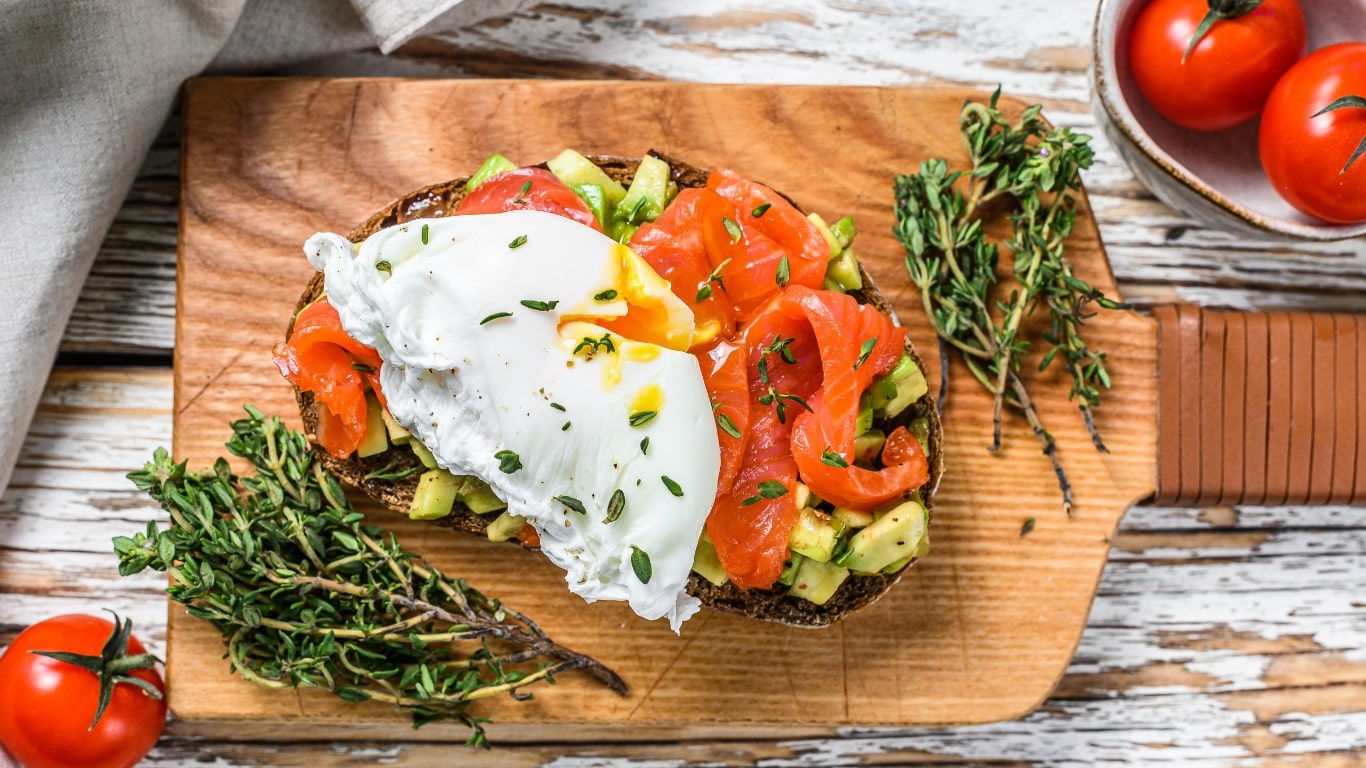
Egg dishes like omelets, scrambled eggs, and quiches are simple yet perfect canvases for thyme’s delicate flavor. Just a small sprinkle of thyme can bring a fresh, herbal element to these dishes.
Thyme has a subtle but distinct flavor that complements the mild richness of eggs. Its earthy and slightly minty qualities add brightness to egg dishes without being too overpowering, giving the dish a more sophisticated flavor profile.
In scrambled eggs or omelets, a pinch of dried thyme or a few fresh thyme leaves can be added just before cooking. In quiches or frittatas, fresh thyme can be mixed into the egg mixture along with other ingredients like cheese, spinach, or bacon. Thyme can also be used in egg-based sauces like hollandaise to add a subtle layer of herbaceous flavor.
Thyme is excellent in quiche Lorraine, spinach and feta omelets, scrambled eggs with mushrooms, or baked egg casseroles. It also pairs well with egg-based sauces, adding a refined herbal note.
Thyme in Sauces
Thyme is a key ingredient in many classic sauces, providing a depth of flavor that enriches the sauce’s overall taste. Its ability to blend seamlessly with other herbs and spices makes it an essential part of sauces, from simple tomato-based varieties to rich, creamy reductions.
Thyme adds a subtle complexity to sauces, whether it’s a basic marinara or a sophisticated wine reduction. It balances the acidity in tomato sauces, enhances the creaminess in béchamel or cream-based sauces, and brings out the richness in wine and butter sauces. Thyme’s earthy, slightly minty flavor is especially effective when combined with garlic, onions, and shallots.
For tomato sauces, thyme can be added at the beginning of cooking, allowing its flavors to meld with the sauce as it simmers. In wine-based reductions or pan sauces, a few sprigs of fresh thyme can be added toward the end of cooking to infuse the sauce with a delicate herbal note. In creamy sauces like béchamel or Alfredo, thyme can be whisked in to create a balanced, aromatic flavor.
Thyme is frequently used in marinara sauce, béchamel, and velouté. It also works well in butter-based sauces for fish or chicken, like lemon-butter sauce or garlic-herb sauce. Thyme enhances gravies for roast meats and can elevate pan sauces made with wine, stock, or balsamic vinegar.
b. Infusing Thyme in Liquids
Thyme’s ability to slowly release its essence when simmered or steeped makes it an ideal herb for infusing liquids, elevating both savory and sweet dishes. Whether you’re preparing a comforting stock, a luxurious herb-infused oil, or a refreshing cocktail, thyme adds depth, complexity, and aromatic richness. Here’s how you can make the most of thyme by infusing it into various liquids.
Stocks and Broths with Thyme
Thyme is a key ingredient in homemade stocks and broths, adding a subtle yet powerful layer of flavor that enhances everything from soups to sauces. By infusing thyme into the liquid base, you allow its earthy, slightly minty, and peppery notes to meld with other ingredients, creating a more complex and flavorful result.
When simmered in stocks or broths, thyme releases its essential oils gradually, infusing the liquid with a warm, earthy aroma and taste. The longer the thyme simmers, the more its flavor intensifies, creating a savory and aromatic foundation for your dish.
Fresh thyme sprigs are often used in stocks. They can be added whole and left to steep while the stock simmers. You can add thyme early in the cooking process, allowing it to break down and infuse the liquid fully. Dried thyme is also effective, though you’ll need less of it since it has a more concentrated flavor. For convenience, you can tie thyme sprigs with other herbs (like bay leaves and parsley) into a bouquet garni, making it easy to remove after cooking.
Thyme-infused stocks are perfect for making soups such as chicken noodle, minestrone, or French onion. Thyme can also elevate the flavor of risottos, stews, gravies, and braising liquids for meats, adding complexity and richness.
Infused Oils and Butters with Thyme
Thyme can be infused into oils and butters, turning these basic cooking staples into flavorful, aromatic condiments. Thyme-infused oils and compound butters can be drizzled over finished dishes or used in the cooking process to add a burst of fresh, herbal flavor.
Thyme-infused oil or butter captures the herb’s earthy and slightly floral notes. The infusion process allows the thyme’s essential oils to disperse into the fat, which holds and preserves the flavor over time. The result is a luxurious, aromatic ingredient that can elevate the simplest of dishes.
To make thyme-infused oil, gently heat olive oil or another neutral oil (like grapeseed or sunflower oil) with a few sprigs of fresh thyme. Heat the oil just enough to allow the thyme’s essence to infuse into the oil but not to the point where it burns. Let the mixture cool, then strain the oil and store it in an airtight container. For compound butter, mix softened butter with finely chopped fresh thyme, a pinch of salt, and other optional herbs or seasonings (like garlic or lemon zest). Roll the butter into a log using parchment paper and refrigerate until firm. You can slice off rounds as needed.
Thyme-infused oils are ideal for drizzling over roasted vegetables, grilled meats, or fresh salads. They can also be used as a dipping oil for bread or as a finishing touch for pasta dishes. Compound thyme butter adds richness to grilled steaks, roasted chicken, or warm bread. It’s also a perfect topping for baked potatoes or steamed vegetables.
Teas and Cocktails using Thyme
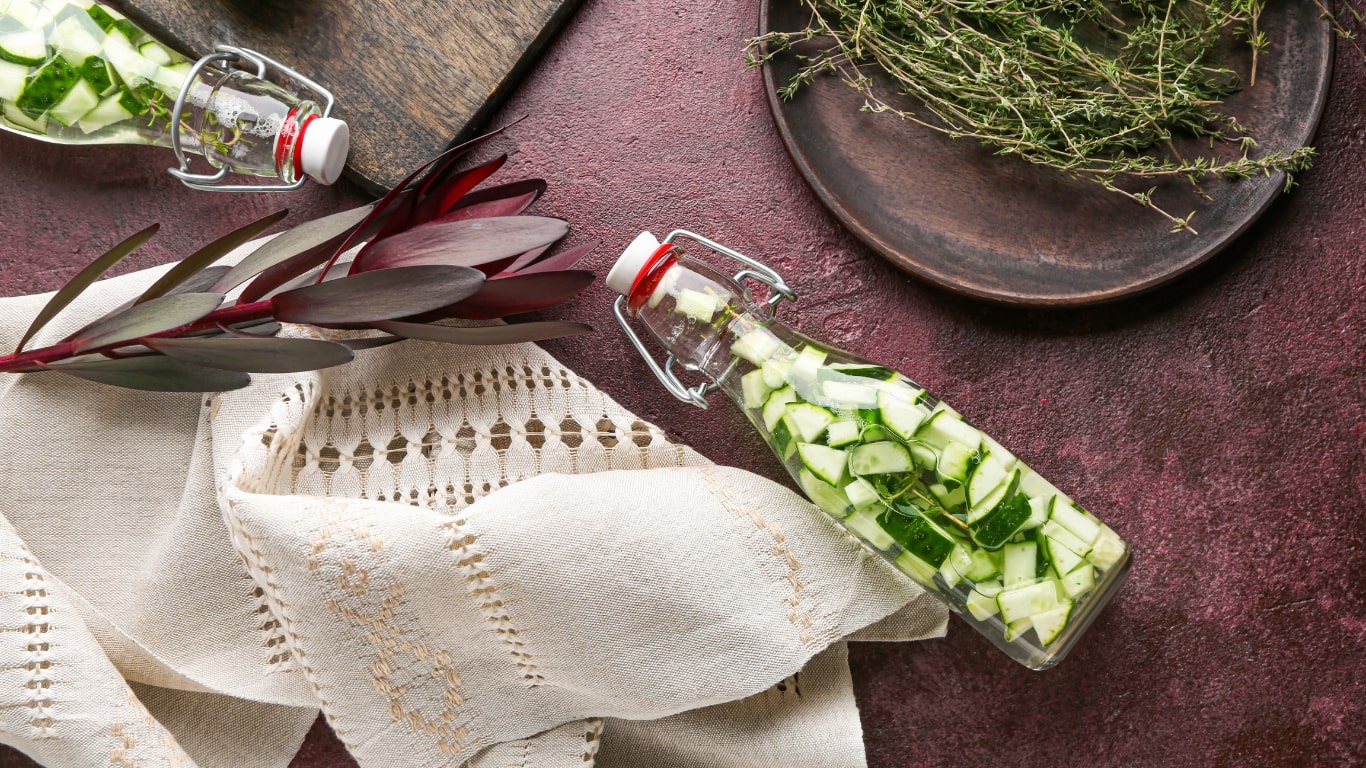
Thyme, especially lemon thyme, can be infused into drinks, offering a bright, citrusy note that pairs beautifully with teas and cocktails. Whether you’re preparing a soothing herbal tea or crafting a unique cocktail, thyme adds an unexpected layer of flavor that can enhance both hot and cold beverages.
Thyme’s subtle herbal taste brings complexity to drinks, adding a balance of earthy and citrusy notes. Lemon thyme, in particular, offers a fresh, lemony flavor that complements a wide range of beverages. When steeped in teas, it imparts a gentle, calming aroma, while in cocktails, it pairs beautifully with various spirits and mixers.
For herbal teas, add a few sprigs of lemon thyme to boiling water and let it steep for several minutes before straining. You can combine it with other herbs like mint, chamomile, or lavender for a more complex blend. For cocktails, thyme can be muddled with citrus fruits or herbs and mixed into spirits like gin, vodka, or rum. You can also infuse simple syrups with thyme by simmering water and sugar with fresh thyme sprigs. This syrup can be used to sweeten and flavor cocktails.
Thyme tea is a soothing, refreshing option on its own or mixed with lemon and honey. It’s especially good for calming the senses and aiding digestion. For cocktails, thyme pairs beautifully with gin-based drinks like a thyme gin fizz or with vodka in a thyme-lemon martini. Thyme-infused simple syrup can be added to margaritas, mojitos, or even a refreshing lemonade for a unique twist.
Thyme-Infused Vinegars and Brines
Thyme’s robust flavor also works well in vinegars and brines, where it adds a fragrant, herbal note to pickled vegetables or marinated meats. Infusing thyme into acidic liquids like vinegar creates a tangy, aromatic solution perfect for salad dressings, marinades, or pickling.
When steeped in vinegar, thyme imparts its herbaceous, slightly minty flavor, which balances the sharpness of the vinegar. This infusion adds complexity to the liquid, making it more than just an acidic component—it becomes a flavor enhancer for marinades, dressings, and pickles.
To make thyme-infused vinegar, heat vinegar (such as white wine vinegar or apple cider vinegar) and pour it over fresh thyme sprigs in a jar. Let it cool, then cover and store in a cool, dark place for 1-2 weeks to allow the flavors to develop. Strain before use. For brines, thyme can be added along with other herbs and spices, infusing meats or vegetables with its earthy flavor as they cure or pickle.
Thyme-infused vinegar is perfect for vinaigrettes, marinades for meats and vegetables, or drizzling over roasted dishes. Thyme-brined chicken, turkey, or pork will have a deep, savory flavor, while pickled vegetables like carrots or cucumbers infused with thyme offer a bright, herbal bite.
Infusing thyme into liquids—whether stocks, oils, butters, or drinks—is an easy yet impactful way to introduce its earthy, aromatic essence into a wide variety of dishes and beverages. By slowly releasing its essential oils, thyme enhances flavors subtly but effectively, adding complexity and depth to everyday meals. Whether you’re simmering thyme in a hearty stock, whipping up a compound butter, or crafting a cocktail with lemon thyme, this versatile herb can take your culinary creations to the next level.
c. Thyme as a Garnish
Fresh thyme sprigs or leaves can be used as a garnish for soups, meats, or even desserts, giving the dish a touch of elegance along with a subtle hint of flavor. Lemon or orange thyme works well for desserts, adding a zesty contrast to sweet flavors.
3. How to Cook with Fresh Thyme
Fresh thyme is a staple in many kitchens, known for its aromatic, earthy flavor that adds depth and complexity to a variety of dishes. Unlike dried thyme, fresh thyme has a more vibrant and nuanced taste, making it a versatile and essential herb in both savory and sweet recipes. Here’s a detailed guide on how to cook with fresh thyme to ensure you make the most of its fragrant qualities.
a. Using Whole Sprigs: For Slow-Cooked Dishes
One of the simplest ways to use fresh thyme is by adding whole sprigs to dishes that involve long cooking times, such as soups, stews, braises, and roasts. The heat from slow cooking allows the essential oils and flavors to release gradually, permeating the dish without overwhelming it. Over time, the tender leaves naturally fall off the stems and blend into the dish, leaving behind just the woody stem, which can be easily removed before serving.
- Flavor Impact: When used in this way, thyme contributes a subtle, background flavor that enhances the overall depth of the dish. Its earthy and slightly peppery notes combine with other ingredients without overpowering them.
- How to Use: Simply rinse the sprigs to remove any dirt, and then add them directly to the dish, usually at the beginning of the cooking process. Because fresh thyme is more delicate than dried thyme, it’s best used in recipes that allow its flavors to develop slowly, like beef stew, chicken soup, or even slow-roasted lamb.
- Tip: If you don’t want to worry about fishing out the stems later, you can tie the thyme sprigs together with kitchen twine or include them in a bouquet garni (a bundle of herbs wrapped in cheesecloth). This makes it easy to remove once the dish is done.
b. Stripping the Leaves: For Quicker Cooking and Precision
For dishes that cook quickly, such as sautés, pastas, and vegetable stir-fries, stripping the leaves from the stems ensures that thyme’s flavor is released instantly and evenly. Since the stems are woody and tough, it’s best to remove the leaves for quicker-cooking recipes where the herb needs to impart its flavor in a shorter amount of time.
- Flavor Impact: Fresh thyme leaves, when stripped from the stem, offer a burst of herbaceous flavor. They are bright, aromatic, and can be used at various points during cooking—whether at the beginning, middle, or as a finishing touch.
- How to Use: Hold the sprig at the top with one hand and use your other hand to gently run your fingers down the stem, stripping off the leaves in one smooth motion. This method ensures you avoid the stem and are left with just the tender leaves. For dishes like pan-seared chicken, scrambled eggs, or roasted potatoes, thyme leaves can be added during cooking for a more pronounced flavor.
- Tip: If your thyme is young and tender, the stems may not be as tough, and they can sometimes be chopped and used as well. However, if the stems are thick and woody, it’s best to discard them.
c. Chopping Thyme: For Even Flavor Distribution
Once the thyme leaves have been removed from the stems, you can use them whole or chop them to distribute the flavor more evenly throughout the dish. Chopping releases more of the essential oils in the thyme, which helps the herb permeate the dish and ensures that every bite is infused with its aromatic quality.
- Flavor Impact: Chopped thyme leaves have a more concentrated flavor, making them ideal for dishes where you want thyme to stand out, like in rubs, marinades, or mixed into batters and doughs. Finely chopped thyme can be mixed into compound butters, salad dressings, or sprinkled on finished dishes for a fresh burst of flavor.
- How to Use: Gather the stripped thyme leaves into a small pile and chop them finely using a sharp knife. Depending on the dish, you can leave the leaves larger for a more rustic look or chop them finely for better integration into sauces, marinades, or dough.
- Tip: If you want to use thyme as a garnish, finely chopped thyme can add an elegant, herbal finishing touch to roasted meats, vegetables, or creamy pasta dishes.
Additional Tips for Cooking with Fresh Thyme
Know When to Add Fresh Thyme
- Early in Cooking: For stews, braises, and slow-roasted dishes, add thyme early in the cooking process. This allows its flavor to slowly infuse into the dish, creating a subtle, underlying herbal note that enhances the other ingredients.
- Late in Cooking or as a Garnish: For dishes that don’t require long cooking times, such as sautéed vegetables, sauces, or grilled meats, add thyme later in the cooking process or as a garnish. This keeps its fresh, vibrant flavor intact and adds a bright finish to the dish.
Storing Fresh Thyme
To maximize the lifespan of fresh thyme, wrap it in a damp paper towel and store it in an airtight container in the refrigerator. Properly stored, fresh thyme can last for up to a week. Alternatively, you can freeze thyme sprigs by placing them in an ice cube tray with olive oil, creating herb-infused cubes that can be used in future cooking
Using Fresh Thyme in Cold Dishes
Fresh thyme can also shine in cold dishes like salads, dips, or vinaigrettes. For these dishes, it’s best to use thyme leaves raw or lightly chopped. Adding thyme to vinaigrettes and marinades can infuse salads and cold appetizers with a fresh herbal note.
Fresh thyme is a versatile and flavorful herb that can elevate any dish, from slow-cooked stews to quick sautés. By knowing how to use whole sprigs, strip the leaves, and chop the herb, you can maximize its flavor and add complexity to your cooking.
4. How to Cook with Dried Thyme
Dried thyme is a pantry staple, offering a convenient and long-lasting way to infuse dishes with its earthy, slightly minty flavor. While fresh thyme brings a brighter and more delicate note, dried thyme provides a more concentrated, robust flavor, making it especially useful in recipes that require longer cooking times. Learning how to use dried thyme effectively will ensure that your dishes capture the full depth of this herb’s potential. Here’s how to make the most of it in your cooking.
a. Crushing the Leaves: Unlocking Essential Oils
Dried thyme is typically sold as small, brittle leaves that have been dried to preserve their flavor. Before adding dried thyme to a dish, it’s a good idea to crush the leaves between your fingers or use a mortar and pestle to break them down further. This step helps release the essential oils locked inside the dried leaves, intensifying the herb’s flavor and aroma.
Crushing dried thyme allows its oils to disperse more evenly throughout the dish, preventing pockets of intense flavor while ensuring a more balanced distribution. Crushing also helps break down the dried leaves into smaller, finer pieces, which means they will integrate better into sauces, soups, or stews.
Simply rub a pinch of dried thyme between your fingers before sprinkling it into the dish. Alternatively, use a mortar and pestle to gently crush a larger amount of thyme if you’re preparing a recipe that calls for several teaspoons.
b. Timing: Adding Dried Thyme Early in the Cooking Process
Unlike fresh thyme, which can be added at various stages of cooking, dried thyme is best incorporated early on, particularly in dishes that require long cooking times like soups, stews, or braises. The heat and moisture from cooking help dried thyme rehydrate and release its full flavor, ensuring that it melds seamlessly with the other ingredients.
Dried thyme has a more concentrated flavor compared to fresh thyme, but its potency can be sharp and overwhelming if not given enough time to mellow. Adding it early ensures the herb has time to soften and integrate, allowing its earthy, savory notes to enhance the dish without overpowering it.
In soups, stews, or sauces, add dried thyme when you’re sautéing onions, garlic, or other aromatic vegetables at the start. This gives the thyme a chance to “bloom” in the heat and release its oils before the liquids are added. For roasted or baked dishes, mix the dried thyme with other seasonings and rubs before the dish goes into the oven.
c. Measurement Conversion: Using the Right Amount
One of the key differences between dried and fresh thyme is the intensity of flavor. Because dried thyme has a more concentrated taste, you need less of it compared to fresh thyme. A general rule of thumb is that dried herbs are about three times as potent as fresh herbs, so when substituting dried thyme for fresh, use one-third the amount.
If a recipe calls for 1 tablespoon of fresh thyme, you can substitute 1 teaspoon of dried thyme. Similarly, if the recipe asks for 1 teaspoon of fresh thyme, use just 1/3 teaspoon of dried thyme.
Using too much dried thyme can overwhelm a dish, as its concentrated flavor becomes more pronounced as it cooks. It’s always better to start with less and add more later if needed, especially when using dried herbs.
Storing Dried Thyme Properly
To ensure that your dried thyme maintains its flavor and potency, proper storage is key. Exposure to light, air, and heat can cause dried thyme to lose its essential oils over time, leading to a less flavorful product.
Keep dried thyme in an airtight container, preferably in a cool, dark place like a pantry or cupboard. Avoid storing it near the stove or in areas with high humidity, as moisture can cause the dried leaves to clump and lose their flavor.
While dried thyme can last for up to one year, it’s a good idea to check the herb regularly. If the thyme no longer has a strong aroma when crushed, it may have lost its potency and should be replaced.
Pairing Dried Thyme with Other Herbs and Spices
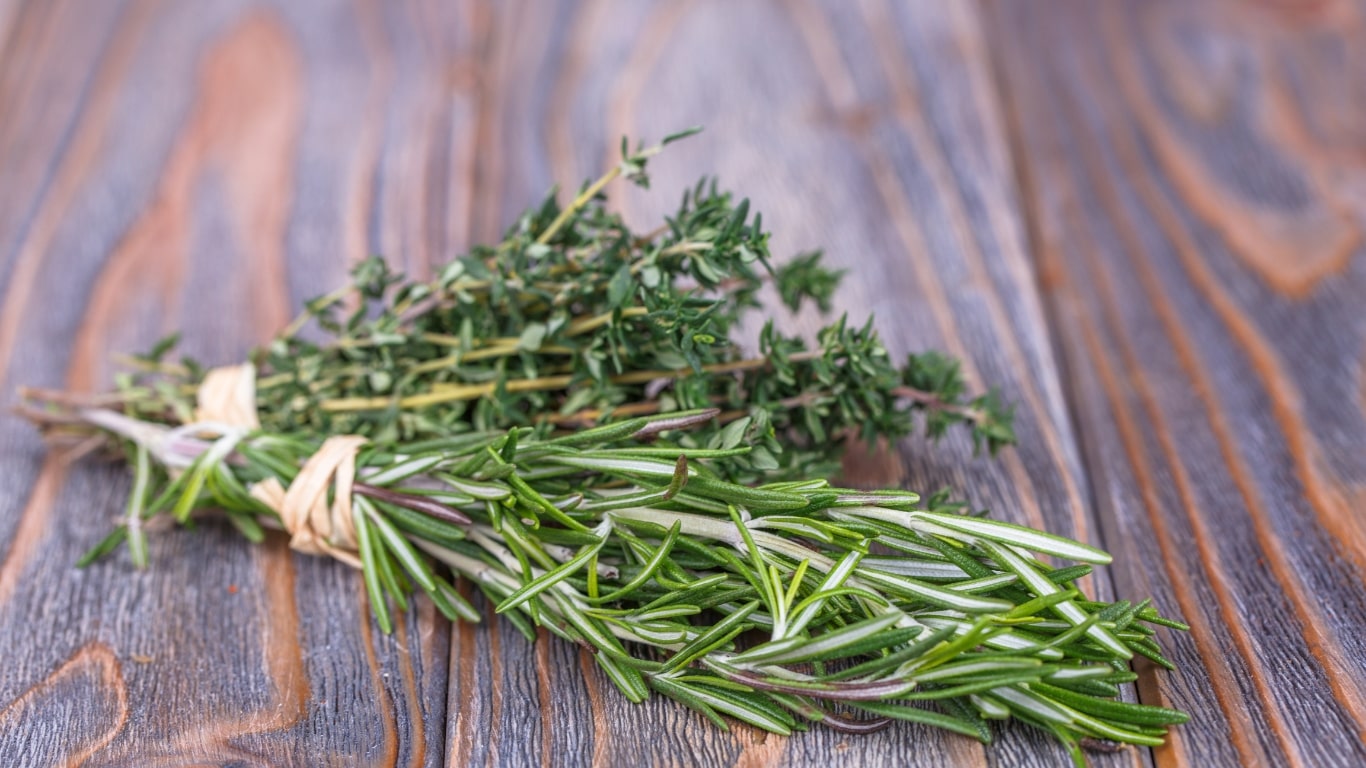
Dried thyme pairs well with a variety of herbs and spices, allowing it to complement many different flavor profiles. Here are a few classic combinations:
- Thyme and Rosemary: This duo is often used in Mediterranean and French cuisine, particularly in meat dishes, roasted vegetables, and breads.
- Thyme and Oregano: Both herbs work beautifully in Italian and Greek dishes, especially in tomato sauces, marinades, and pizza.
- Thyme and Bay Leaves: These herbs are commonly paired in soups, stews, and braises. Bay leaves add a subtle, floral note, while thyme provides a more earthy, robust flavor.
- Thyme and Garlic: A perfect pairing for roasted meats, vegetables, and sauces, the combination of thyme and garlic is a cornerstone of many savory dishes.
- Thyme and Lemon: Thyme’s earthy flavor pairs wonderfully with the bright, acidic notes of lemon, making this combination ideal for poultry, seafood, and vinaigrettes.
Dried thyme is a versatile herb that, when used properly, can elevate the flavor of a wide variety of dishes. By crushing the leaves, adding it early in the cooking process, and using the right measurement, you can make the most of its concentrated, earthy flavor.
5. Flavor Pairings with Thyme
Thyme is celebrated for its unique flavor profile, which balances earthy, minty, and slightly peppery notes. This versatile herb can elevate a myriad of dishes, making it a beloved staple in kitchens around the world. Understanding its complementary flavors can help you unlock its full potential in your cooking. Below are some of the best flavor pairings with thyme, showcasing its adaptability across various cuisines.
a. Lemon and Garlic: Brightness Meets Earthiness
Lemon and garlic are two ingredients that shine when paired with thyme, enhancing its natural characteristics while adding brightness and depth.
- Lemon: The acidity and citrus notes of lemon harmonize beautifully with thyme, making it ideal for marinades and dressings. When combined, they can enhance the flavors of poultry, seafood, and roasted vegetables. For example, a lemon-thyme marinade for chicken can create a zesty, aromatic dish that is both refreshing and flavorful.
- Garlic: Garlic’s pungent, savory flavor pairs seamlessly with thyme, especially in dishes that require sautéing or roasting. A classic example is lemon-garlic roast chicken seasoned with thyme, where the garlic’s richness balances the herb’s earthiness, creating a harmonious blend of flavors. Additionally, garlic-infused olive oil with thyme can serve as a delicious drizzle over pasta or vegetables.
b. Olive Oil and Tomatoes: The Essence of Mediterranean Cooking
Thyme is a cornerstone of Mediterranean cuisine, particularly when combined with olive oil and tomatoes.
- Olive Oil: The richness of high-quality olive oil complements thyme’s herbaceous notes, creating a base for many dishes. Whether used in salad dressings, marinades, or drizzled over roasted vegetables, olive oil infused with thyme brings a savory richness that enhances the dish’s overall flavor. For instance, thyme-infused olive oil can be used to sauté vegetables or as a dipping oil for bread.
- Tomatoes: Thyme is frequently used in tomato-based sauces, stews, and soups, where its earthy flavor elevates the natural sweetness of tomatoes. A classic tomato and thyme sauce can be used for pasta, pizzas, or as a base for braised meats. The combination brings out the best in both ingredients, creating a deep, rich flavor profile that is quintessentially Mediterranean.
c. Onions and Mushrooms: A Flavorful Foundation
Thyme works particularly well with alliums like onions and fungi such as mushrooms, enhancing their natural sweetness and umami qualities.
- Onions: Caramelized onions develop a sweet, rich flavor that pairs wonderfully with thyme. The herb enhances the complexity of dishes like onion soup, quiches, or savory tarts. A thyme-infused onion and cheese tart, for example, combines the sweetness of the onions with the herb’s earthy notes, resulting in a delicious and comforting dish.
- Mushrooms: The umami flavor of mushrooms complements thyme exceptionally well, making this pairing perfect for risottos, sautés, and casseroles. A mushroom thyme risotto can deliver a creamy, rich flavor profile, while thyme can also enhance the depth of flavors in dishes like mushroom stroganoff or a hearty vegetable stew.
d. Wine and Vinegar: Balancing Acidity and Flavor
Thyme’s herbal notes are a natural match for acidic ingredients like wine and vinegar, creating a well-rounded flavor experience.
- Wine: Both red and white wines can be used to deglaze pans or as a base for marinades, sauces, and braises. Thyme is often included in recipes for wine-based sauces, where its flavors meld with the richness of the wine. For instance, a red wine reduction with thyme can add depth to a beef dish, while a white wine and thyme sauce can elevate fish or chicken.
- Vinegar: The acidity of vinegar balances the earthiness of thyme, making it an excellent addition to salad dressings and pickling recipes. A simple vinaigrette made with balsamic vinegar, olive oil, and thyme can brighten up salads or roasted vegetables. Similarly, thyme-infused vinegar can be used in marinades or drizzled over dishes for an extra layer of flavor.
e. Other Flavor Pairings
While the above combinations highlight thyme’s most popular companions, it also pairs well with a variety of other ingredients:
- Fruits: Thyme can enhance both sweet and savory fruit dishes. Pairing thyme with fruits like peaches, apricots, or figs in desserts or savory salads can add an intriguing herbal note.
- Cheese: Thyme pairs beautifully with many cheeses, especially soft cheeses like goat cheese or ricotta. A spread made with fresh thyme and cream cheese can elevate appetizers or serve as a flavorful filling for pastries.
- Spices: Thyme works well with spices like black pepper, nutmeg, and paprika, adding warmth and complexity to a variety of dishes. Its flavor can enhance spice blends used for grilling or roasting.
Thyme is an incredibly versatile herb that complements a wide range of flavors and ingredients. By understanding its best flavor pairings—such as lemon, garlic, olive oil, tomatoes, onions, mushrooms, wine, and vinegar—you can enhance your dishes and create a harmonious balance of flavors.
6. Preserving Thyme, Ensuring Long-Lasting Flavor
Preserving thyme allows you to enjoy its aromatic flavor long after the growing season has ended. Both fresh and dried thyme can be stored effectively, ensuring that you have this versatile herb on hand for your culinary needs. Below are detailed methods for preserving thyme, including freezing and drying techniques, along with tips for maintaining flavor and quality.
a. Freezing Fresh Thyme
Freezing is one of the best methods for preserving the fresh flavor and aroma of thyme. Here’s how to do it effectively:
Harvesting Thyme: Begin by selecting healthy, vibrant sprigs of fresh thyme. Ideally, you want to harvest thyme in the morning after the dew has dried, as this is when the essential oils are most concentrated.
Preparing for Freezing
- Option 1: One popular method is to chop fresh thyme leaves and place them in an ice cube tray. Fill each compartment with olive oil or water, making sure the thyme is submerged. Once frozen, transfer the thyme cubes to a resealable freezer bag or container. This method creates convenient portions that can be added directly to soups, stews, or sauces.
- Option 2: Alternatively, you can freeze whole sprigs of thyme. Simply rinse them under cold water, pat them dry, and place them in a single layer on a baking sheet. Freeze the sprigs for a few hours until solid, then transfer them to a freezer bag. This method allows you to use whole sprigs in cooking without chopping.
Using Frozen Thyme: When you need thyme for cooking, you can use the frozen sprigs or cubes straight from the freezer without thawing. This helps retain the flavor and aroma, making it an excellent option for recipes that require slow cooking or simmering.
b. Drying Thyme
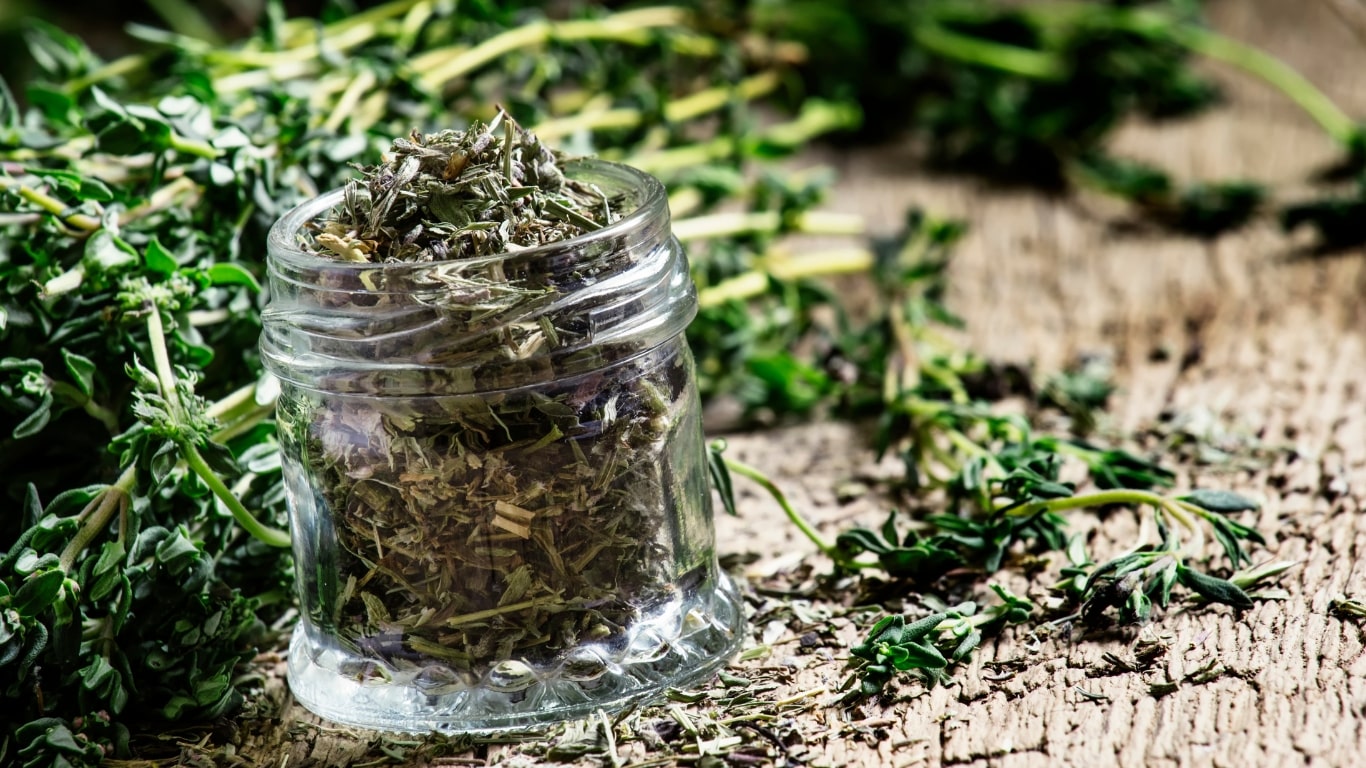
Drying is another effective method for preserving thyme, allowing you to enjoy its concentrated flavor for months. Here’s a step-by-step guide to drying thyme at home:
Harvesting and Preparing Thyme: Similar to freezing, harvest fresh thyme in the morning for the best flavor. Choose stems that are healthy and free from blemishes. Rinse the sprigs gently under cold water to remove any dirt or insects, then pat them dry with a clean towel.
Drying Methods
- Air Drying: This is the simplest method. Gather small bunches of thyme and tie them together with kitchen twine. Hang the bundles upside down in a warm, dry, and well-ventilated area, away from direct sunlight. A kitchen or pantry works well. Depending on humidity levels, it may take anywhere from one to two weeks for the thyme to dry completely. The leaves should feel brittle and crumble easily when rubbed between your fingers.
- Oven Drying: For a quicker method, you can dry thyme in the oven. Preheat your oven to the lowest setting (around 170°F or 75°C). Spread the thyme sprigs in a single layer on a baking sheet lined with parchment paper. Place the sheet in the oven and keep the door slightly ajar to allow moisture to escape. Check every 30 minutes, and remove the thyme once the leaves are dry and crumbly, which usually takes 1 to 2 hours.
- Dehydrator: If you have a food dehydrator, this can be an effective way to dry thyme. Spread the sprigs on the dehydrator trays and set the temperature according to the manufacturer’s instructions. Typically, drying thyme at around 95°F (35°C) will yield good results in a few hours.
Storing Dried Thyme: Once the thyme leaves are dry, strip them from the stems by running your fingers down the length of the stem. Store the dried leaves in an airtight container, such as a glass jar or a resealable bag, away from light and heat. Properly dried and stored thyme can last up to a year without significant loss of flavor.
Tips for Maintaining Flavor and Quality
- Labeling: Always label your containers with the date of preservation. This helps you keep track of freshness and ensures you use the oldest herbs first.
- Avoiding Moisture: Ensure that both fresh and dried thyme are completely dry before storing. Moisture can lead to mold or spoilage, diminishing the quality of your preserved thyme.
- Using Desiccants: For extra protection against moisture, consider adding a desiccant packet (like those found in supplement bottles) to your storage container. This can help absorb any humidity that might affect your dried herbs.
- Using Within the Year: While dried thyme can last up to a year, its flavor may diminish over time. For the best flavor, aim to use your preserved thyme within six months to a year, and consider replenishing your supply annually.
Preserving thyme, whether through freezing or drying, is a practical way to keep this aromatic herb on hand for your culinary adventures. By following these methods, you can ensure that you have fresh and flavorful thyme available year-round. Whether you prefer the vibrant taste of fresh thyme or the concentrated flavor of dried thyme, proper preservation techniques will enhance your cooking and allow you to enjoy the delightful taste of thyme in your favorite dishes.
7. Cooking Techniques with Thyme
Understanding different cooking techniques can help you maximize the flavor of thyme in your meals. Here’s a detailed exploration of various cooking methods that highlight thyme’s unique characteristics, providing you with the knowledge to elevate your culinary creations.
a. Sautéing: Building Flavor from the Base
Sautéing is a foundational cooking technique that allows thyme to release its essential oils and flavor early in the cooking process, setting the stage for a delicious dish.
When sautéing, add thyme at the beginning along with aromatic ingredients like garlic and onions. This allows the herb to infuse the oil, releasing its fragrant oils and enhancing the overall flavor of the dish. For example, starting a vegetable stir-fry with olive oil, minced garlic, and thyme creates a flavorful base that carries through to the final dish.
Thyme pairs well with a variety of vegetables, including bell peppers, zucchini, and mushrooms. Sautéing these vegetables with thyme can create a delightful side dish or serve as a base for pasta, grain bowls, or frittatas. Additionally, when sautéing meat, such as chicken or pork, thyme adds depth and complexity, transforming a simple dish into something truly special.
For an even more pronounced flavor, consider making a thyme-infused oil by gently heating olive oil with fresh thyme before using it in your sauté. This oil can be drizzled over vegetables or proteins for added richness and aroma.
b. Roasting: Enhancing Flavor Through Caramelization
Roasting is an excellent method for utilizing thyme, as the dry heat of the oven intensifies its flavor and allows it to meld beautifully with the ingredients.
Tossing whole sprigs of thyme with vegetables or meats before roasting is a fantastic way to infuse the dish with its fragrant oils. The high heat helps to release the oils in the thyme, enhancing the natural sweetness of roasted root vegetables, such as carrots, potatoes, and parsnips.
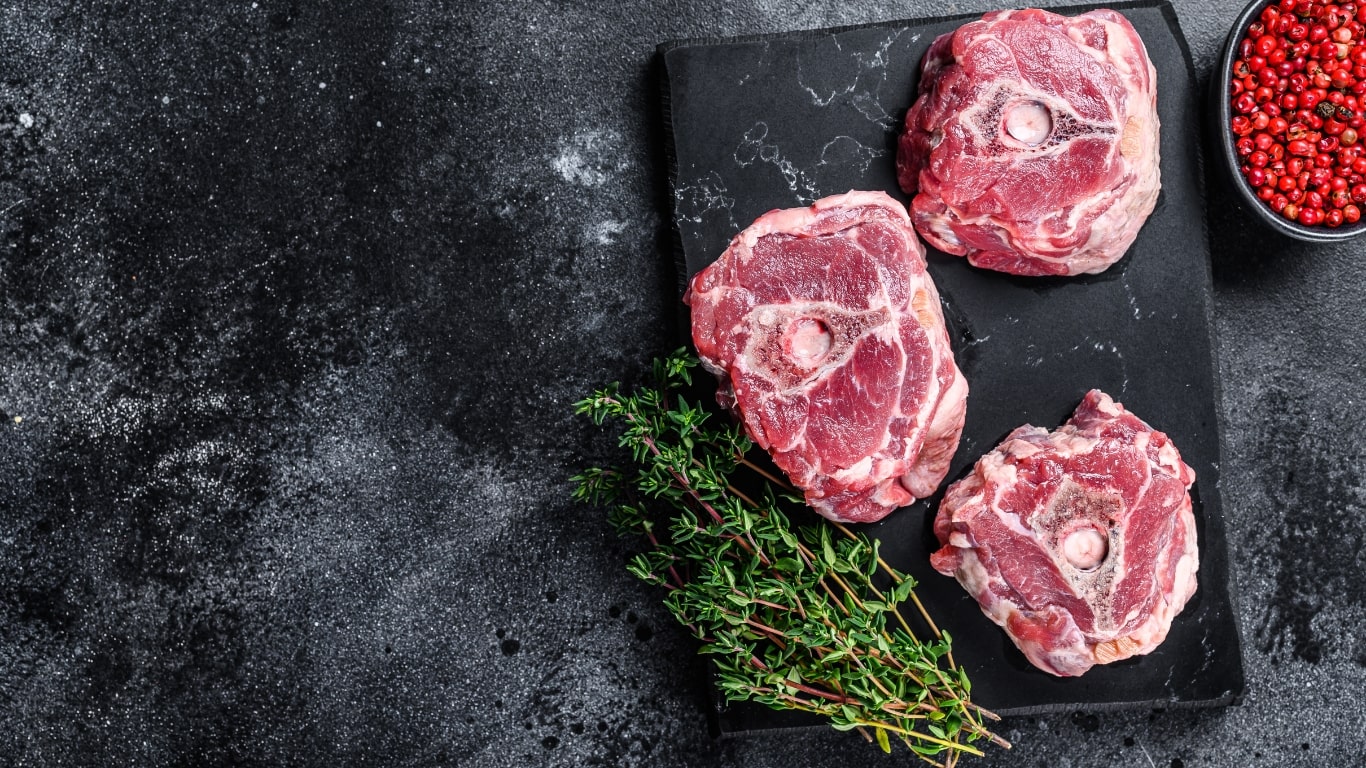
Thyme works particularly well with roasted meats like chicken, lamb, or beef. Creating a herb rub with thyme, garlic, and olive oil and massaging it into the meat before roasting can impart a deep, aromatic flavor. This technique is especially effective when roasting a whole chicken, as the thyme flavors permeate the meat during the cooking process, resulting in a succulent and flavorful dish.
Thyme can also be combined with other herbs like rosemary and sage to create a more complex flavor profile. This herb blend can be used to season vegetables or meats for a robust flavor experience that complements the natural characteristics of the ingredients.
c. Grilling: Adding Depth and Smokiness
Grilling brings out a unique aspect of thyme’s flavor, particularly its herbal notes, while adding a hint of smokiness that can enhance a wide range of dishes.
For meats, poultry, or fish, rub thyme directly onto the protein before grilling. Combine thyme with complementary ingredients like lemon juice, garlic, olive oil, and spices to create a marinade that enhances flavor while tenderizing the meat. This technique works beautifully for dishes like grilled lemon-thyme chicken or thyme-marinated steak.
Another method is to throw fresh thyme sprigs directly onto the grill grates while cooking. As they heat up, they release their essential oils, infusing the food with a subtle herbaceous flavor. This technique is particularly effective for grilling fish or vegetables, adding an aromatic dimension to the dish that is both refreshing and savory.
Incorporating thyme into skewered meats and vegetables is another way to enhance grilled dishes. For example, threading shrimp, bell peppers, and cherry tomatoes onto skewers with fresh thyme sprigs can create a flavorful and visually appealing dish. The thyme’s oils will infuse the skewered items as they cook, creating a deliciously aromatic meal.
d. Braising: Deepening Flavor Over Time
Braising is a slow cooking method that allows thyme to develop its flavor gradually, resulting in a rich and complex dish.
When braising meats or vegetables, add thyme early in the process, along with other aromatics like onions, carrots, and garlic. As the dish simmers, the thyme will release its oils, creating a deep, flavorful broth that enhances the overall dish.
Thyme is particularly effective in braised dishes that feature a sauce, such as a red wine reduction or a savory broth. For example, a classic coq au vin uses thyme to enhance the flavors of the chicken, wine, and vegetables as they cook slowly, resulting in a rich, aromatic dish.
Braised dishes often benefit from a finishing touch of fresh thyme sprinkled on top before serving. This not only adds a pop of color but also a burst of fresh flavor that contrasts beautifully with the richness of the braised dish.
Buying Thyme in Singapore
When it comes to enhancing your culinary creations, quality matters, and that’s why buying thyme herbs from our shop in Singapore is a fantastic choice. Our fresh and dried thyme is sourced from reputable suppliers, ensuring that you receive the finest quality herbs to elevate your dishes. Whether you’re sautéing, roasting, or infusing flavors, our thyme will add that aromatic depth you crave. Located conveniently in Singapore, our shop offers a variety of thyme options to suit every recipe and cooking style. Experience the vibrant flavor of thyme herbs and discover how they can transform your meals into gourmet delights. Visit us today to stock up on thyme and unlock the full potential of your cooking!
Conclusion
Thyme is a kitchen staple that deserves a place in every pantry. Its ability to blend seamlessly with a variety of ingredients, combined with its distinctive yet versatile flavor, makes it an essential herb for cooks of all levels. Whether you’re making hearty stews, delicate sauces, or simple roasted vegetables, thyme can bring your dishes to life with its aromatic and earthy essence. By mastering how to use both fresh and dried thyme in your cooking, you’ll unlock new layers of flavor in your meals, making them more memorable and satisfying.
